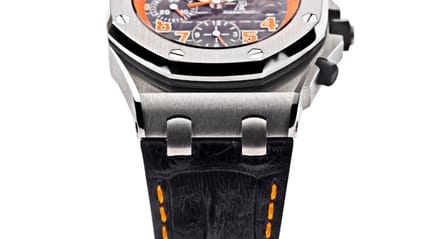
Advertisement feature: what to consider when buying a luxury watch
Some handy tips if you're looking to buy...

Materials

Apart from telling the time, a watch is also an exercise in materials science. Typical materials include stainless steel (lightweight and unlikely to corrode), ceramic (heat-resistant with a touch of modernist style) and titanium (half the weight of steel but twice as strong, though expensive). Then there's white, red and yellow gold, or, if you're feeling flush, platinum. All are strong, but pricey, and a lower carat equals softer metal prone to scratching. Silver and bronze are also out there, but rarely used, due to their delicacy. Finally, there are chemical or diamond-like carbon coatings (often used by Bell & Ross), for a thin but tough veneer.
Advertisement feature in partnership with the watchgallery.co.uk
Advertisement - Page continues below
/* Style Definitions */ table.MsoNormalTable {mso-style-name:"Table Normal"; mso-tstyle-rowband-size:0; mso-tstyle-colband-size:0; mso-style-noshow:yes; mso-style-parent:""; mso-padding-alt:0cm 5.4pt 0cm 5.4pt; mso-para-margin:0cm; mso-para-margin-bottom:.0001pt; mso-pagination:widow-orphan; font-size:12.0pt; font-family:"Times New Roman"; mso-ascii-font-family:Cambria; mso-ascii-theme-font:minor-latin; mso-hansi-font-family:Cambria; mso-hansi-theme-font:minor-latin; mso-ansi-language:EN-US;}
Movements
Choosing a mechanical watch movement is a bit like choosing an engine for your car. Some are made in bigger volumes, used by several brands, while others are made in watchmakers' own workshops and exist in only a few models. Those made on a smaller scale tend to be more complicated and better-looking, although those produced in larger volumes tend to be more durable. Generally, an in-house one will be more expensive, but will hold its value longer. The best-known of the in-house makers is Rolex, which, along with Patek Philippe and Zenith, produce many thousands of movements each year. For real rarity and examples of exotic micro-engineering, look to more boutiquey firms such as Jaeger-LeCoultre.
Advertisement feature in partnership with the watchgallery.co.uk
Testing

If your watch has been ejected from a plane, it'll probably be OK if you drop it down the side of the bed. These are the extremes some manufacturers go to when testing their timepieces. For its MB range, Bremont demanded that each watch could survive a fighter plane ejection. So they strapped one to a test pilot's wrist, sent him up into the skies and pulled the big red lever... Less hardcore, but still important, development cash goes into things like accuracy. Some chronographs, for example, are certified by the COSC, the independent Swiss body that sets the stringent standards for such things.
Advertisement feature in partnership with the watchgallery.co.uk
Advertisement - Page continues belowInvestment

Choose your watch wisely, and it could be worth a lot more in the future. An expert might be able to spot a future classic, but if you're not enough of a boffin to identify one now, consider a limited edition. Thanks to good old-fashioned principles of supply and demand, something like IWC's Ingenieur Automatic Edition - limited to just 36 British-bound examples (pictured, below) - could tempt buyers who failed to get their hands on one first time around. Some of the most valuable editions include small parts from salvaged cars, ships or aeroplanes. They may not cost a fortune, either. For more inspiration, click on the ‘limited editions' tab on The Watch Gallery website.
Advertisement feature in partnership with the watchgallery.co.uk
Function

Think about how you'll use your watch. Not everyone will be plunging to the depths of the Mediterranean, but if that's your sort of thing, look for a diving watch with high water resistance and a special bezel to mark elapsed dive time (a Breitling Superocean would do the trick). Some will simply want something that looks nice on their wrist, in which case a classic design without complications should work well in a meeting or at a dinner party. Those looking for a bit more performance could consider chronographs, which are especially useful for recording lap times on track days (see the Alpina Racing, right). Any pilots among you could consider something with a large, legible face for easy time-telling when searching for a foggy runway with an imminent landing slot (a Zenith Pilot, perhaps).
Advertisement feature in partnership with the watchgallery.co.uk
History

Like Germany with its motor cars and Scotland with its whisky, Switzerland has had lots of time to get this watch business sorted. Some of the best - and oldest - companies started in small workshops in Geneva and the Jura region hundreds of years ago, and it was their inventions and industrial processes that informed the watch world that we know today. Swiss watch royalty includes Audemars Piguet, Baume & Mercier and TAG Heuer, all of which could be regarded, somewhat ironically, as ‘timeless'. Many other watchmakers have copied them, while some have innovated with new tech. But without the work of these early few, we'd still be staring at the Moon, wondering if it's time for breakfast.
Advertisement feature in partnership with the watchgallery.co.uk

Advertisement feature in partnership with the watchgallery.co.uk
The Watch Gallery is the UK's leading independent watch retailer, stocking premium Swiss-made brands selected by a team of in-house experts with the knowledge to help you choose the right watch, and to help you care for it. Remember, owning a luxury watch is like having a nice car. You need to know it's authentic, and it'll need regular servicing to keep it running well. To find out more, visit the website.
Advertisement - Page continues below
Trending this week
- Car Review
BMW iX3






